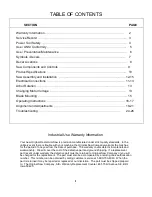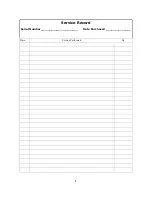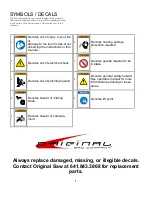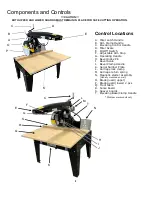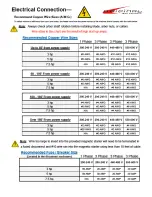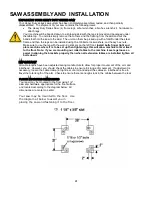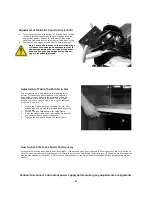
6
6
Modifications:
−
Any modifications to the machine including incorpora-
tion into an
assembly, addition of integrated feeds or
other changes are the responsibility of the end user
and the end user must ensure ongoing compliance.
Additional Safety Actions to be Take by End
User
−
Lock out Tag out procedures to be adopted during all
maintenance.
−
Lock out Tag out procedures to be observed when
changing blade
Functional Testing
−
Braking time test—tested monthly
(20 second brake run down )
−
Upper Guard locking—tested monthly, prove there is
an inability to open upper guard without tools.
−
Test lower guards for hang ups make sure upper plas-
tic section drop down to cover blade
−
Test lower ring guard (inner) test to make sure it moves
freely, it is not bent, and does not hang up–
must drop
freely to lower portion of blade
General instructions for Safe Use:
−
•
Always observe the safety instructions and applicable
−
regulations.
−
•
Ensure the material to be sawn is firmly secured in place.
−
•
Apply only a gentle pressure to the tool and do not exert
side
−
pressure on the saw blade.
−
•
Avoid overloading.
−
•
Install the appropriate saw blade. Do not use excessively
worn blades. The maximum rotation speed of the tool must
not exceed that of the saw blade.
−
•
Do not attempt to cut excessively small pieces.
−
•
Allow the blade to cut freely. Do not force.
−
•
Allow the motor to reach full speed before cutting.
−
•
Make sure all locking knobs and clamp handles are tight.
−
•
Never run the machine without the guards in place.
−
•
Never lift the machine by the table top.
Preventative Maintenance —
Continued
−
Weekly
−
Perform daily PM tasks and then also:
−
Make sure spring return pulls carriage back behind the
fence from any position in the arm.
−
Look at saw blade, make sure it is free of cracks and is
sharp,
−
Review all safety labeling and make sure they are intact
and legible, if they are damaged order replacements
from Original Saw Company.
−
−
Monthly / Bi
-
Monthly
—Every 160 hours of use:
−
Disconnect power from machine
−
Remove saw blade, end cap, and stop bolt pull out car-
riage and gently rest the carriage assembly on the table
top.
−
Wipe down the machined tracks with denatured alcohol
or paint thinner to remove any residual wood pitch
buildup.
Note do not lubricate the tracks
.
−
Wipe down the bearings with denatured alcohol or paint
thinner to remove any residual wood pitch buildup.
Check for free movement if there are any bad bearings
have them replaced–
they will cause wear and damage.
−
Review all cords for cracks replace if damaged.
−
Reassemble the carriage in the arm, reinstall stop bolt,
end cap. Check for looseness in the carriage or left to
right movement specifically near the fence area.
−
The column should be wiped down with a clean dry rag,
if there are any wood pitch please use denatured alcohol
or pain thinner to remove then keep column dry.
−
Vacuum the table and inside the frame to make sure
sawdust is not building up in those areas.
−
Annually / Bi
-
Annually
−
Adjustment and alignment of saw is necessary only when
cutting results in unacceptable accuracy but yearly take a
square and double check alignment as shown starting on
page 18.
−
After many years of use your saw may need replace-
ment parts. If any of the following wears out all others
listed should be checked also.
−
Arm Tracks: If the saw is used primarily for short cut
-
offs, the tracks may wear making it difficult to adjust the
roller head bearing for full length arm travel. Arms can
generally be re
-
machined—contact Original Saw for pric-
ing and shipping instructions.
−
Motor bearings: Check for free, smooth rotation. Do not
attempt to lubricate. Replace every 5 years with factory
original bearings. Or if unit is used more than 6
-
8 hours
per day replace every 2 years.
−
Elevating mechanism: Remove, clean and lubricate with
type EP grease. Check for wear between nut and jack
screw. Replace assembly if loose.
Preventative Maintenance
Original Radial Arm Saws are designed to provide you with
precision cutting with a minimal amount of maintenance.
The frequency of the maintenance depends on the amount of
use and the desired cutting quality.
Always disconnect and lockout power supply before per-
forming maintenance.
−
Daily
:
−
Wipe down the machined tracks in the arm with a dry
clean cloth. Removing this dust will keep it from building
up on the tracks.
−
Glance at the guards and make sure the upper guard is
in good shape free from damage and the lower movea-
ble portions have free movement and are not binding.
Use and Preventative Maintenance
Summary of Contents for 3531-01
Page 11: ...11 11...


